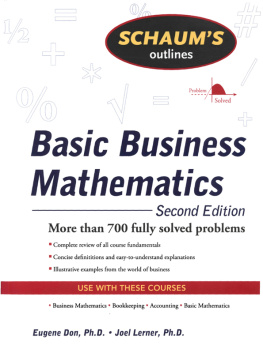Leonard J. Kazmier - Schaums Outline of Business Statistics
Here you can read online Leonard J. Kazmier - Schaums Outline of Business Statistics full text of the book (entire story) in english for free. Download pdf and epub, get meaning, cover and reviews about this ebook. City: Ney York;USA, year: 2009;2004, publisher: McGraw-Hill Professional Publishing, genre: Home and family. Description of the work, (preface) as well as reviews are available. Best literature library LitArk.com created for fans of good reading and offers a wide selection of genres:
Romance novel
Science fiction
Adventure
Detective
Science
History
Home and family
Prose
Art
Politics
Computer
Non-fiction
Religion
Business
Children
Humor
Choose a favorite category and find really read worthwhile books. Enjoy immersion in the world of imagination, feel the emotions of the characters or learn something new for yourself, make an fascinating discovery.

- Book:Schaums Outline of Business Statistics
- Author:
- Publisher:McGraw-Hill Professional Publishing
- Genre:
- Year:2009;2004
- City:Ney York;USA
- Rating:5 / 5
- Favourites:Add to favourites
- Your mark:
- 100
- 1
- 2
- 3
- 4
- 5
Schaums Outline of Business Statistics: summary, description and annotation
We offer to read an annotation, description, summary or preface (depends on what the author of the book "Schaums Outline of Business Statistics" wrote himself). If you haven't found the necessary information about the book — write in the comments, we will try to find it.
Schaums Outline of Business Statistics — read online for free the complete book (whole text) full work
Below is the text of the book, divided by pages. System saving the place of the last page read, allows you to conveniently read the book "Schaums Outline of Business Statistics" online for free, without having to search again every time where you left off. Put a bookmark, and you can go to the page where you finished reading at any time.
Font size:
Interval:
Bookmark:
SCHAUMS OUTLINE OF
Business Statistics
Business Statistics
Fourth Edition
Leonard J. Kazmier, Ph.D.
W.P. Carey School of Business
Arizona State University
Schaums Outline Series


Copyright 2004, 1996, 1988, 1976 by The McGraw-Hill Companies, Inc. All rights reserved. Except as permitted under the United States Copyright Act of 1976, no part of this publication may be reproduced or distributed in any form or by any means, or stored in a database or retrieval system, without the prior written permission of the publisher.
ISBN: 978-0-07-170245-4
MHID: 0-07-170245-8
The material in this eBook also appears in the print version of this title: ISBN: 978-0-07-163527-1, MHID: 0-07-163527-0.
All trademarks are trademarks of their respective owners. Rather than put a trademark symbol after every occurrence of a trademarked name, we use names in an editorial fashion only, and to the benefit of the trademark owner, with no intention of infringement of the trademark. Where such designations appear in this book, they have been printed with initial caps.
McGraw-Hill eBooks are available at special quantity discounts to use as premiums and sales promotions, or for use in corporate training programs. To contact a representative please e-mail us at bulksales@mcgraw-hill.com.
TERMS OF USE
This is a copyrighted work and The McGraw-Hill Companies, Inc. (McGraw-Hill) and its licensors reserve all rights in and to the work. Use of this work is subject to these terms. Except as permitted under the Copyright Act of 1976 and the right to store and retrieve one copy of the work, you may not decompile, disassemble, reverse engineer, reproduce, modify, create derivative works based upon, transmit, distribute, disseminate, sell, publish or sublicense the work or any part of it without McGraw-Hills prior consent. You may use the work for your own noncommercial and personal use; any other use of the work is strictly prohibited. Your right to use the work may be terminated if you fail to comply with these terms.
THE WORK IS PROVIDED AS IS. McGRAW-HILL AND ITS LICENSORS MAKE NO GUARANTEES OR WARRANTIES AS TO THE ACCURACY, ADEQUACY OR COMPLETENESS OF OR RESULTS TO BE OBTAINED FROM USING THE WORK, INCLUDING ANY INFORMATION THAT CAN BE ACCESSED THROUGH THE WORK VIA HYPERLINK OR OTHERWISE, AND EXPRESSLY DISCLAIM ANY WARRANTY, EXPRESS OR IMPLIED, INCLUDING BUT NOT LIMITED TO IMPLIED WARRANTIES OF MERCHANTABILITY OR FITNESS FOR A PARTICULAR PURPOSE. McGraw-Hill and its licensors do not warrant or guarantee that the functions contained in the work will meet your requirements or that its operation will be uninterrupted or error free. Neither McGraw-Hill nor its licensors shall be liable to you or anyone else for any inaccuracy, error or omission, regardless of cause, in the work or for any damages resulting there from. McGraw-Hill has no responsibility for the content of any information accessed through the work. Under no circumstances shall McGraw-Hill and/or its licensors be liable for any indirect, incidental, special, punitive, consequential or similar damages that result from the use of or inability to use the work, even if any of them has been advised of the possibility of such damages. This limitation of liability shall apply to any claim or cause whatsoever whether such claim or cause arises in contract, tort or otherwise.
This book covers the basic methods of statistical description, statistical inference, decision analysis, and process control that are included in introductory and intermediate-level courses in business statistics.
The concepts and methods are presented in a clear and concise manner, and lengthy explanations have been minimized in favor of presenting concrete examples. Because this book has been developed particularly for those whose interest is the application of statistical techniques, mathematical derivations are omitted.
When used as a supplement to a course text, the numerous examples and solved problems will help to clarify the mathematical explanations included in such books. This Outline can also serve as an excellent reference book because the concise manner of coverage makes it easier to find required procedures. Finally, this book is complete enough in its coverage that it can in fact be used as the course textbook.
This edition of the Outline has been thoroughly updated, and now includes computer-based solutions using Excel (copyright Microsoft, Inc.), Minitab (copyright Minitab, Inc.), and Execustat (copyright PWS-Kent Publishing Co.).
LEONARD J. KAZMIER
SCHAUMS OUTLINE OF
Theory and Problems of
BUSINESS STATISTICS
Analyzing Business Data
Statistics refers to the body of techniques used for collecting, organizing, analyzing, and interpreting data. The data may be quantitative, with values expressed numerically, or they may be qualitative, with characteristics such as consumer preferences being tabulated. Statistics is used in business to help make better decisions by understanding the sources of variation and by uncovering patterns and relationships in business data.
Descriptive statistics include the techniques that are used to summarize and describe numerical data for the purpose of easier interpretation. These methods can either be graphical or involve computational analysis (see ).
EXAMPLE 1. The monthly sales volume for a product during the past year can be described and made meaningful by preparing a bar chart or a line graph (as described in Section 2.11). The relative sales by month can be highlighted by calculating an index number for each month such that the deviation from 100 for any given month indicates the percentage deviation of sales in that month as compared with average monthly sales during the entire year.
Inferential statistics include those techniques by which decisions about a statistical population or process are made based only on a sample having been observed. Because such decisions are made under conditions of uncertainty, the use of probability concepts is required. Whereas the measured characteristics of a sample are called sample statistics, the measured characteristics of a statistical population, or universe, are called population parameters. The procedure by which the characteristics of all the members of a defined population are measured is called a census. When statistical inference is used in process control, the sampling is concerned particularly with uncovering and controlling the sources of variation in the quality of the output. through 7 cover probability concepts, and most of the chapters after that are concerned with the application of these concepts in statistical inference.
EXAMPLE 2. In order to estimate the voltage required to cause an electrical device to fail, a sample of such devices can be subjected to increasingly higher voltages until each device fails. Based on these sample results, the probability of failure at various voltage levels for the other devices in the sampled population can be estimated.
Next pageFont size:
Interval:
Bookmark:
Similar books «Schaums Outline of Business Statistics»
Look at similar books to Schaums Outline of Business Statistics. We have selected literature similar in name and meaning in the hope of providing readers with more options to find new, interesting, not yet read works.
Discussion, reviews of the book Schaums Outline of Business Statistics and just readers' own opinions. Leave your comments, write what you think about the work, its meaning or the main characters. Specify what exactly you liked and what you didn't like, and why you think so.


